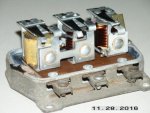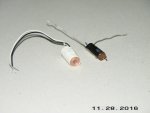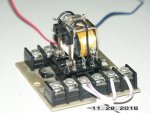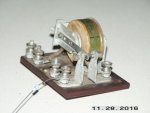You are using an out of date browser. It may not display this or other websites correctly.
You should upgrade or use an alternative browser.
You should upgrade or use an alternative browser.
POTENTIAL RELAY
- Thread starter domnic
- Start date
- Status
- Not open for further replies.
gar
Senior Member
- Location
- Ann Arbor, Michigan
- Occupation
- EE
161127-1457 EST
Need some comas.
395 --- probably means the maximum allowed continuous voltage. In other words heat dissipation in the relay coil.
pick up voltage min 208 max 239 --- probably means the adjustment range over which the relay can be adjusted for pull-in, or if there is no adjustment, then pull-in occurs somewhere in that range.
drop out voltage min 60 max 130 --- if this is not an electronically controlled voltage relay, then this means drop-out occurs somewhere in the 60 to 130 range.
.
Need some comas.
395 --- probably means the maximum allowed continuous voltage. In other words heat dissipation in the relay coil.
pick up voltage min 208 max 239 --- probably means the adjustment range over which the relay can be adjusted for pull-in, or if there is no adjustment, then pull-in occurs somewhere in that range.
drop out voltage min 60 max 130 --- if this is not an electronically controlled voltage relay, then this means drop-out occurs somewhere in the 60 to 130 range.
.
What he said is accurate re:the voltages
be respectful please
these specs are similar to yours
typically used for 1 ph motor starting with run and start caps
http://www.electrica.it/file_pdf/electrica_rva.pdf
60 Hz
operating Vmax 420 vs 395
PU 204-233 vs 208-239
DO 60-121 vs 60-130
sequence of operation
The coil is energised by the potential of the start winding. When such voltage is raised up to the pick-up value, the contact will open and disconnect the start capacitor. The relay will remain energised untilthe start winding voltage is removed or decreases to less than the drop-out value.
be respectful please
these specs are similar to yours
typically used for 1 ph motor starting with run and start caps
http://www.electrica.it/file_pdf/electrica_rva.pdf
60 Hz
operating Vmax 420 vs 395
PU 204-233 vs 208-239
DO 60-121 vs 60-130
sequence of operation
The coil is energised by the potential of the start winding. When such voltage is raised up to the pick-up value, the contact will open and disconnect the start capacitor. The relay will remain energised untilthe start winding voltage is removed or decreases to less than the drop-out value.
ptonsparky
Tom
- Occupation
- EC - retired
Used with submersible pump motors, some older table and radial arm saws. Limits of my exposure.
- Location
- Massachusetts
You probably do not know what your talking about .
And you don't seem to be able to ask a coherent question.
StarCat
Industrial Engineering Tech
- Location
- Moab, UT USA
- Occupation
- Imdustrial Engineering Technician - HVACR Electrical and Mechanical Systems
HVACR and Pump Applications Single Phase
HVACR and Pump Applications Single Phase
The main necessity in dealing with these relays is to never replace them except with the exact correct rating of what the original was.
Otherwise you can damage and burn the start winding on said motor in short order. There are all kinds of cross reference charts put out by Mars, Steveco, and OEMs that can allow one to find a match for whats needed. Common failures are points burned closed, or coil open less common. More often than not they will destroy the motor in question before the first cause failure is detected. The bleed off resistor on HVAC start capacitors is designed to save those contact points service life.
HVACR and Pump Applications Single Phase
The main necessity in dealing with these relays is to never replace them except with the exact correct rating of what the original was.
Otherwise you can damage and burn the start winding on said motor in short order. There are all kinds of cross reference charts put out by Mars, Steveco, and OEMs that can allow one to find a match for whats needed. Common failures are points burned closed, or coil open less common. More often than not they will destroy the motor in question before the first cause failure is detected. The bleed off resistor on HVAC start capacitors is designed to save those contact points service life.
gar
Senior Member
- Location
- Ann Arbor, Michigan
- Occupation
- EE
161128-1000 EST
domnic:
Following are photos of some potential relays (voltage, can also be current) that probably don't fit your definition of a potential relay.
.

The left relay is a potential relay. This oscillates rapidly to adjust the average current to the field of a DC generator. It is the voltage regulator relay. This is about 60 years old and for a 6 V system. Probably a 52 Mercury.
The middle relay is a current limiting relay that also oscillates when necessary to adjust field excitation to limit maximum load current on the generator. When in current limiting it is obvious that voltage regulation is lost.
The right relay is a combination voltage and current relay, commonly called a cut-out relay, used to prevent the battery from backfeeding the generator when the generator voltage is too much below the battery voltage. Today a diode might be used, but the cut-out relay might waste less power.
My classmate's father invented an aspect of this regulator that reduced manufacturing cost.
.

These are reed relays. One without the reed and the other with. Depending upon the winding the relay can be either a current or voltage relay.
.

A very conventional P&B KUP relay, 24 V DC.
.

A sensitive relay, low power. Probably not a good way to get sensitivity today.
.
.
domnic:
Following are photos of some potential relays (voltage, can also be current) that probably don't fit your definition of a potential relay.
.

The left relay is a potential relay. This oscillates rapidly to adjust the average current to the field of a DC generator. It is the voltage regulator relay. This is about 60 years old and for a 6 V system. Probably a 52 Mercury.
The middle relay is a current limiting relay that also oscillates when necessary to adjust field excitation to limit maximum load current on the generator. When in current limiting it is obvious that voltage regulation is lost.
The right relay is a combination voltage and current relay, commonly called a cut-out relay, used to prevent the battery from backfeeding the generator when the generator voltage is too much below the battery voltage. Today a diode might be used, but the cut-out relay might waste less power.
My classmate's father invented an aspect of this regulator that reduced manufacturing cost.
.

These are reed relays. One without the reed and the other with. Depending upon the winding the relay can be either a current or voltage relay.
.

A very conventional P&B KUP relay, 24 V DC.
.

A sensitive relay, low power. Probably not a good way to get sensitivity today.
.
.
POTENTIAL RELAY continuous voltage 395 pick up voltage min 208 max 239 max drop out voltage min 60 max 130 can someone put these voltages in prospective .
Question is vague.
Hihi, make a box put the cardboards with voltage labels and name the box prospective. In that way, you had put the voltages in propective.
gar
Senior Member
- Location
- Ann Arbor, Michigan
- Occupation
- EE
161128-1215 EST
Early history of the automotive voltage regulator:
w.org/First-Hand:The_Story_of_the_Automobile_Voltage_Regulator
https://www.google.com/patents/US3023354 This might be an interesting patent to study. I briefly looked at the introduction and claim 1. In a quick look at claim 1 did not see anything to pop out that would distinguish it from prior art.
.
Early history of the automotive voltage regulator:
w.org/First-Hand:The_Story_of_the_Automobile_Voltage_Regulator
https://www.google.com/patents/US3023354 This might be an interesting patent to study. I briefly looked at the introduction and claim 1. In a quick look at claim 1 did not see anything to pop out that would distinguish it from prior art.
.
gar
Senior Member
- Location
- Ann Arbor, Michigan
- Occupation
- EE
161128-21345 EST
A working link to the automotive voltage regulator story.
http://ethw.org/First-Hand:The_Story_of_the_Automobile_Voltage_Regulator
Also see https://www.google.com/patents/US2033014
.
A working link to the automotive voltage regulator story.
http://ethw.org/First-Hand:The_Story_of_the_Automobile_Voltage_Regulator
Also see https://www.google.com/patents/US2033014
.
Last edited:
gar
Senior Member
- Location
- Ann Arbor, Michigan
- Occupation
- EE
161128-1540 EST
If one follows certain paths it is interesting to see what turns up.
At the end of patent US2033014 one finds that this patent was referenced by 2557298 filed May 20, 1946.
For those not familiar with patents the following wording from the patent gives you perspective on the significance of claims:
Then the first claim is :
On my superficial reading of this claim, without further analysis, it seems to possibly imply that this is the first patent to cover an automotive alternator with DC output and voltage and current regulation.
Different subject. Doing some ancestry research I traced a possible path back to 1030 AD. Starting about 1300 I started to see some individuals living into their 80s. This I had not expected.
.
If one follows certain paths it is interesting to see what turns up.
At the end of patent US2033014 one finds that this patent was referenced by 2557298 filed May 20, 1946.
For those not familiar with patents the following wording from the patent gives you perspective on the significance of claims:
Although our invention has been illustrated and described herein in more or less detail, it will be understood of course that the invention is not intended to be correspondingly limited in scope but should be regarded as including all changes and modifications coming within the scope of the appended claims.
Then the first claim is :
1. In combination with a motor vehicle having a driving engine, an electrical system for supplying power to a direct current load comprisin an alternator, torque transmitting means connecting the alternator with said engine to be driven thereby, a rectifier, means connecting said rectifier and direct current load in circuit with said alternator, voltage regulating means of the electromagnetic vibratory type connected with said alternator and rectifier and operable by rectified current from the latter to regulate the operation of said alternator for controlling the terminal voltage of the alternator, and a load limiting device of the electromagnetic vibratory type in said circuit and operable to limit the power delivery through the circuit to a predetermined safe value for the rectifier.
On my superficial reading of this claim, without further analysis, it seems to possibly imply that this is the first patent to cover an automotive alternator with DC output and voltage and current regulation.
Different subject. Doing some ancestry research I traced a possible path back to 1030 AD. Starting about 1300 I started to see some individuals living into their 80s. This I had not expected.
.
gar
Senior Member
- Location
- Ann Arbor, Michigan
- Occupation
- EE
161128-1941 EST
When I look at the claim 1 quoted in post #12 I see this claim reading on existing electromagnetic vibratory type systems predating this patent application by 10 years except for: --- alternator in place of DC generator and the addition of a rectifier. Were these two differences sufficient to make the invention un-obvious to one skilled in the art? Apparently so. 2557298 was issued June 19, 1951. Thus, potentially had life into the period of actual production. Was this claim ever fought in court? I don't know.
If vibrating electromechanical devices (electromagnetic vibratory type) had been described as an electrically modulating means, then I believe that the claim would have also read on semiconductor devices, but as written I believe a semiconductor means used to modulate field current would circumvent this claim. Just a comment on how to think about writing claims.
It was not until the late 1950s that alternators started to show up on cars. Same time frame for transistor radios.
My comments are here simply to provide some insight on patents in case you ever think of patenting something.
It is interesting to note that Westinghouse invented the Ignitron around 1930, but thru various amendments, and therefore delay of issue, the patent provided protection until about 1960. Starting in the mid 1960s the SCR replaced the Ignitron.
.
.
When I look at the claim 1 quoted in post #12 I see this claim reading on existing electromagnetic vibratory type systems predating this patent application by 10 years except for: --- alternator in place of DC generator and the addition of a rectifier. Were these two differences sufficient to make the invention un-obvious to one skilled in the art? Apparently so. 2557298 was issued June 19, 1951. Thus, potentially had life into the period of actual production. Was this claim ever fought in court? I don't know.
If vibrating electromechanical devices (electromagnetic vibratory type) had been described as an electrically modulating means, then I believe that the claim would have also read on semiconductor devices, but as written I believe a semiconductor means used to modulate field current would circumvent this claim. Just a comment on how to think about writing claims.
It was not until the late 1950s that alternators started to show up on cars. Same time frame for transistor radios.
My comments are here simply to provide some insight on patents in case you ever think of patenting something.
It is interesting to note that Westinghouse invented the Ignitron around 1930, but thru various amendments, and therefore delay of issue, the patent provided protection until about 1960. Starting in the mid 1960s the SCR replaced the Ignitron.
.
.
Last edited:
- Status
- Not open for further replies.
